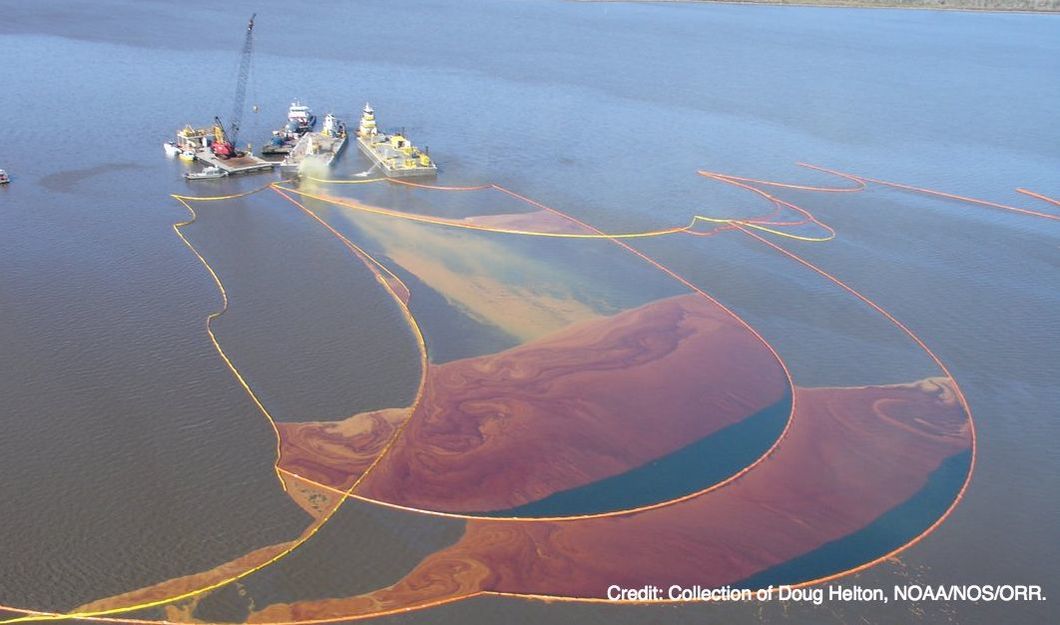|
More than 30 years after the ship went down in Canadian waters, a difficult clean up is now underway!
The Manolis L, a 400-foot cargo vessel carrying a load of newsprint, hit a rock and sunk off the coast of Notre Dame Bay in Newfoundland, Canada, in 1985. Now more than thirty years later, efforts are underway to clean up oil from the shipwreck before it can pollute the bay. The wreck, believed to contain 463 tons of heavy fuel and 60 tons of diesel fuel, remained largely intact until 2013, when a powerful storm caused cracks in the weakened hull. People soon started reporting oily sheens on the water, and the Canadian Coast Guard began a cat and mouse game of trying to plug the cracks, but to no avail. This spring the Canadian Federal Government awarded a 15 million dollar contract to salvage the wreck and protect the bay. The plan is for a salvage vessel, in coordination with two remotely operated underwater vehicles, to drill into the hull and then pump the oil from the wreck, which lies in 70 meters of water near Change Islands on Newfoundland's northeast coast. Residents of the area are thrilled that the wreck is finally being cleaned up and the threat of further oil leakage is being addressed. Carolyn Parsons, one of the leaders of a local group that has been lobbying the government to clean up the wreck since 2013, first became aware of the problem when she was sent a photo of her niece holding a bird covered in oil. "We’re really excited to see this finally come to its conclusion," Parson, now the co-chair of the Manolis L Citizen's Response Committee, told The Globe and Mail. “People are just really concerned that one day everything would be destroyed,” she said, describing the sense of threat hanging over the local commercial fishery industry and natural environment. The unfolding story of the Manolis L goes to show that the threat of marine oil pollution can come from many sources, including decades old shipwrecks! It's also a reminder that when oil pollution is preventable, such as preventing illegal discharges from ships, we should do everything we can to keep oil from entering our waters. Read more about this story in the Globe and Mail and the Telegram. A new study finds that oil is still present across the Gulf of Mexico seven years after the Deepwater Horizon Oil spill of 2010.
Researchers at the University of South Florida recently published the results of a seven-year study on marine life in the Gulf of Mexico. The study spanned 12 research expeditions, and included data on 15,000 fish, representing 166 species from 343 locations. The goal of the research was to obtain a baseline understanding of marine life in the Gulf to better be able to evaluate the long term impacts of the Deepwater Horizon oil spill of 2010. One key finding was that oil from the spill is still detectable across the gulf and that none of the areas included in the study were oil-free. Fish specimens caught for the study were tested for pollutants like oil and heavy metals, and while oil contamination in the Gulf has declined since the catastrophic spill in 2010, it is still present. "Neither the fish nor oil spills know national boundaries," principal investigator Steve Murawski, Ph.D., professor at the University of South Florida College of Marine Science, told Phys.org. "Providing seamless data for the Gulf as a whole is imperative if we are to prepare adequately for future oil spills." The seven years of research by Dr. Murawski and his colleagues only marks the beginning of improving our understanding of the Gulf of Mexico and the long tern consequences of the spill. They have created an invaluable foundation for future scientists to better evaluate the changing health of the Gulf ecosystem. Learn more about the study at Phys Org and the American Fisheries Society. |
Details
AuthorMarine Defenders is an educational program designed to reduce chronic oil pollution. Archives
February 2019
Categories
All
|


 RSS Feed
RSS Feed